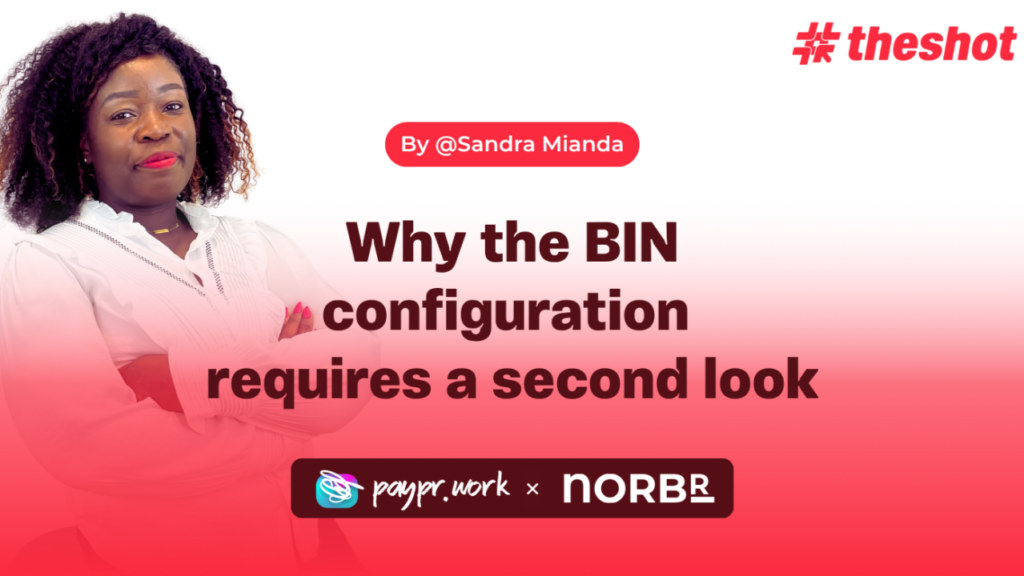
Last month, the team at NORBr launched The Shot, a new initiative spotlighting key payment challenges, unpacked from the lens of payment strategists. As the inaugural collaborator, I had the opportunity to kick-start the conversation with a focused dive into how BIN setup can make or break payment performance.
Few components in the acquiring stack are as consistently underestimated as BINs. They’re often well understood as a series of digits that carry different identification attributes. But in practice, how BINs are configured, interpreted, and acted upon by the ecosystem has a direct influence on approval rates, fee structures, compliance alignment, and even how fraud rules are applied.
Over the past few months, we’ve supported a number of merchant-side reviews where the BIN setup was quietly eroding conversion, whether through misrouting, outdated categorisation, or misaligned issuer logic.
So le’ts recap our insights on BINs and outline some of the patterns we’ve observed that we think can be helpful.
Key Takeaways on BINs:
A BIN (Bank Identification Number) refers to the first 6 or 8 digits of a card number and serves as an essential signal in payment processing. It identifies the issuing institution, card type (credit, debit, prepaid), funding source (consumer or commercial), card level (e.g. Classic, Gold), and country of issuance.
This data helps determine how a transaction is routed, priced, risk-scored, and whether any exemptions apply. Acquirers and PSPs parse the BIN early in the transaction flow to decide on the appropriate network (e.g. Visa, Mastercard) and processing logic. With so much metadata embedded in a few digits, BINs play a central role in how payments are handled across the chain.
The importance of BIN data has increased as payments have become more modular. In environments where orchestration is used or multiple acquirers are integrated, the BIN becomes a key reference point in how logic is applied. Quite often, merchants don’t realise just how much BIN logic can influence success or failure at checkout, either tanking approval rates (by incorrectly flagging legitimate transactions as fraud) or becoming a lever for performance (through optimised BIN routing that reduces transaction costs).
”Industries like travel and digital content routinely use BIN ranges to filter which cards to accept or block, driven by geo restrictions, cost pressures, or fraud signals. But if the BIN logic is misapplied, due to outdated data, incorrect classification, or overly rigid rules, it can backfire. Legitimate transactions get declined, revenue takes a hit, and customers are left frustrated. The BIN data is central to keeping flows optimised and predictable.” Sandra M. nda, Paypr.work Founder

Originally, the primary purpose of BINs was to identify the issuing bank and facilitate the correct routing of transactions. This was essential for ensuring that the transaction was sent to the right place for authorisation. Over time, the role of BINs has expanded significantly are now central to how acquiring flows are interpreted and used to inform decisions related to risk management, fee calculation, geographic restrictions, funding source identification, and compliance.
This shift has practical implications. For businesses accepting cards across multiple geographies or working with more than one PSP, the way BINs are set up can directly affect transaction outcomes. Inaccurate or incomplete BIN categorisation may lead to issues such as unexpected flags, misaligned interchange rates, or missed opportunities for applying 3DS exemptions.
BINs also interact with network tokens, account updater services, and chargeback rules. When a token is created, it links back to the original BIN, and if that BIN’s profile changes or is misread, the token’s routing can become compromised. These are nuances that merchants often don’t see, but feel in the form of unexpected declines or higher costs.
Yet, despite their crucial role, BIN tables remain some of the most outdated datasets across the payments chain. Most acquirers and PSPs only update them once or twice a year, while issuers are launching new card products, attributes, and configurations at pace.The responsibility to ingest and reconcile those changes sits with each provider. That creates a systemic lag: by the time the PSP reflects a new BIN range, that product may already be shaping the merchant payment performance, without them even knowing.
There’s been a clear explosion of new issuers, products, and geographies, led by embedded finance (integrating financial services into non-financial platforms), BaaS (Banking-as-a-Service), and multi-market models (businesses operating in multiple countries). And with that, come subtle BIN-level nuances (like new virtual card issuers with unrecognised BIN ranges) that directly influence conversion, on both the issuing and acquiring side. This shift is already pushing the industry toward 10-digit BINs

BIN configurations are often handled at onboarding and can sometimes can left untouched for years. That might have worked when issuers maintained predictable behaviour and scheme logic was static. But today, issuer profiles shift regularly, funding sources blur, and scheme mandates evolve.
When BIN logic isn’t actively maintained, the classifications and routing rules tied to those BINs fall out of sync with real-world issuer behaviour. The consequences aren’t always immediate or obvious. Instead, they reveal themselves gradually: conversion rates dip, fees increase, and dispute ratios rise. By the time these patterns are noticed, performance has already been compromised.
That’s why regular review cycles and the ability to override defaults in partnership with PSPs are no longer best-practice suggestions, they’re essential parts of operational hygiene.
It’s not just about keeping BIN tables up to date. It’s about being able to track how BIN-related rules and classifications change over time and understanding the impact of those changes. Without that visibility, it becomes difficult to trace when and why a certain card started behaving differently in a payment flow.
Was it reclassified by the issuer?
Did your PSP apply a new label?
Did a scheme rule shift in the background?
Improved BIN management unlocks tangible wins. Updating BIN profiles can enhance retry logic, refine exemption strategies, and recover transactions that might otherwise be lost. In some cases, simply correcting a mislabelled BIN in a PSP’s system can open up access to exemptions or better-priced corridors.
Where BIN logic is weak, friction follows. Common failure points include:
These gaps quietly erode performance. They don’t always show up in top-line dashboards, but they shape underlying approval patterns, average transaction costs, and exemption success rates.

One of the most persistent challenges in BIN operations is the lack of transparency around how BIN tables are sourced, structured, and maintained. Most merchants don’t have access to the actual BIN tables used by their PSPs or visibility into how those BINs are classified behind the scenes. Even scheme tables may diverge from what the PSP implements in practice. Add in token metadata or wrapper logic, and the inconsistencies multiply.
While some BIN directories are publicly available online, they don’t solve the problem. They often lack real-time updates, omit commercial logic used by PSPs, and don’t reflect how BINs are interpreted in live routing, pricing, or exemption decisions.
”In other words, just having a list of BINs isn’t the same as knowing how they’re being applied inside your stack.”
This opacity makes it incredibly difficult for merchants to pinpoint why a transaction was flagged, why a card was priced a certain way, or why an exemption failed. And without insight into how BIN logic is applied end-to-end, even the best optimisation efforts can hit invisible walls.
Merchants should push for BIN-level reporting, especially when working with orchestration platforms or acquirers offering flexible routing. As the payment stack becomes increasingly data-driven, transparency into BIN interpretation needs to catch up.
The rise of new and evolving card programmes, across fintech issuers, embedded finance platforms, and global wallets is introducing significant variation in how cards behave and how they should be classified. Products that once fit neatly into debit, credit, or prepaid categories now carry blended attributes, wrapped credentials, or dynamic funding sources that shift across use cases and geographies.
This evolution is exposing a deeper issue: the BIN infrastructure wasn’t designed to support this level of variability. The original 6-digit format lacks the granularity to distinguish between today’s more complex product types, issuer configurations, and funding models. To compensate, schemes have begun expanding BINs to 8 and even 10 digits, aiming to provide more precise segmentation.
However, the expansion alone is not resolving the problem, it’s introducing new complexity. Adoption of longer BINs is fragmented across schemes, PSPs, token providers, and acquirers. Some systems continue to operate on 6-digit logic, others partially recognise 8-digit BINs, and few are fully equipped for 10-digit structures. As a result, the same card can be interpreted differently across the stack, impacting routing decisions, fee application, exemption eligibility, and compliance status.
Without coordinated adoption, clear governance, and system-wide transparency, the shift to longer BINs risks amplifying existing misalignment. Rather than solving for precision, it may deepen the fragmentation unless actively managed.
What to watch for
There is a disconnect between scheme tables, token metadata, and real-world PSP behaviour. For now, one thing is clear: getting the BIN layer right isn’t a technical clean-up. It’s a strategic lever, one that sits quietly under most payments strategies, until something breaks.
𝑾𝒐𝒏𝒅𝒆𝒓 𝒘𝒉𝒐 𝒘𝒆 𝒂𝒓𝒆? 𝘞𝘦 𝘢𝘳𝘦 𝘢 𝘵𝘦𝘢𝘮 𝘰𝘧 𝘗𝘢𝘺𝘮𝘦𝘯𝘵𝘴 𝘚𝘵𝘳𝘢𝘵𝘦𝘨𝘪𝘴𝘵𝘴 𝘣𝘭𝘦𝘯𝘥𝘪𝘯𝘨 𝘰𝘶𝘳 𝘪𝘯𝘥𝘶𝘴𝘵𝘳𝘺 𝘦𝘹𝘱𝘦𝘳𝘵𝘪𝘴𝘦 𝘸𝘪𝘵𝘩 𝘢 𝘤𝘳𝘦𝘢𝘵𝘪𝘷𝘦 𝘢𝘱𝘱𝘳𝘰𝘢𝘤𝘩 𝘵𝘰 𝘢𝘴𝘴𝘪𝘴𝘵 𝘰𝘶𝘳 𝘤𝘭𝘪𝘦𝘯𝘵𝘴 𝘵𝘩𝘳𝘰𝘶𝘨𝘩 𝘊𝘰𝘯𝘴𝘶𝘭𝘵𝘪𝘯𝘨, 𝘚𝘵𝘳𝘢𝘵𝘦𝘨𝘺, 𝘙𝘦𝘴𝘦𝘢𝘳𝘤𝘩 𝘢𝘯𝘥 𝘛𝘩𝘰𝘶𝘨𝘩𝘵 𝘓𝘦𝘢𝘥𝘦𝘳𝘴𝘩𝘪𝘱 𝘱𝘳𝘰𝘫𝘦𝘤𝘵𝘴.
For more payment insights, follow Paypr.work [ˈpeɪpəwəːk]. If your payment set up is not delivering commercial or operational value, get in touch for an independent assessment: intro@paypr.work or DM me Sandra M.
Paypr.work blends payment knowledge and custom research into a simplified yet insightful narration. Our narratives feature visually engaging designs that break down both fundamental and complex payment jargons into bite-sized, repetitive micro-concepts to promote better comprehension and retention.
Sign up for a Paypr.work Premium Membership to exclusively access all of our payment resources, including our full articles, industry insights, ecosystem maps, reports, videos, and our unique library of bespoke infographics.
Don’t miss out— sign up to learn payments in a captivating way!



You have provided so much light and knowledge in a fascinating world. You definitely bring the fun to Fintech like no one else and actually know what you are talking about! Thanks goodness for you😁!

Vice President Global Product Expansion, Shift4
Impressive, congratulations Sandra and Team Paypr.work. The detail in each of your 100+ infographics is outstanding and showcases your expertise well… Continued success for this remarkable work!

LinkedIn Strategist | Digital Transformation Leader

Host of Heads Talk
Your diagrams have the ability to explain the most complicated of topics in way that can be understood by anyone. Not many people have the ability to create self-explanatory visuals, so keep doing your magic 🔥🔥🔥!

CEO & Co Founder of CLOWD9
Your content is so informative, accurate, and fabulously presented in infographics that always attract great attention. Your visuals naturally spark strong engagement regardless of the LinkedIn algorithms !

B2B Marketing, Marqeta
The depth of Paypr.work knowledge and skill sets are truly impressive. Their ability to combine deep industry expertise with well-depicted visual is pretty unique. I strongly recommend Sandra and Paypr.work !

Director EMEA Payment Solutions, Marriott International
👏👏 👏👏 👏👏 I always love your content and in fact, I am so happy for all of us in the industry… we’re lucky to have you sharing your payment wisdom with us 🤓… thank you! Keep up the great work.

Strategic Accounts Director, Truelayer | Payments and Fintech Geek
Merci Sandra pour ta facilité à vulgariser le paiement via de simples dessins, qui me surprendront toujours. Pour ceux qui ne connaissent pas son travail, je vous invite à suivre Paypr.work [ˈpeɪpəwəːk]!

Product Manager Paiement, Maisons du Monde
Your enthusiasm and ability to simplify Payments is so refreshing and literally shines through! Sandra and her team research, write content and create some stunning infographics for the payments industry….

Chief Operations Officer, Clowd9
Keep up the good work and know that your hard work and dedication is so inspiring for all of us. You are truly doing an incredible job and your consistent efforts don’t go unnoticed.

Chief Community Officer, NORBr | Redefining Payment Infrastructure | Linkedin Top Voice
Your posts are a masterclass in how payments have evolved from a basic utility to a strategic asset. Your ability to simplify this complexity and provide strategic direction along with implementation support is so invaluable. The clarity and depth you provide are exactly what this fast-evolving industry needs.

Chief Commercial and Operations Officer, Soffid
The mechanics of all things payment are a black box for most industry stakeholders. With the help of their well researched and designed infographics, Sandra and her team at Papr.work demystify complex flows and create awareness about the factors that play a role in the end to end processes.

Paul van Alfen | Managing Director Managing, Up in the Air - Travel Payment Consultancy
Your Paypr.work subscription gets you full access to all Paypr.work content in 1 place including: our weekly new payments articles, our infographic blog, exclusive discounts on all the services that Paypr.work has to offer and the opportunity to collaborate on free infographic to promote your knowledge/value proposition and more. The content is for personal use and cannot be copied, reproduced, redistributed, altered, modified, shared publicly or with third-party nor can derivatives of the work be created. The user may share content that is available through the free blog access subject to crediting Paypr.work with the attributions.